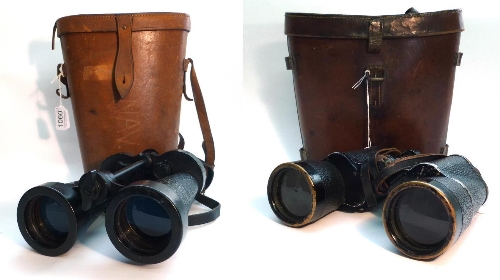Barr and Stroud was founded by Archibald Barr and William Stroud. The new range of Barr & Stroud binoculars are currently made in China (Nov.
Manufacturer/Model: Barr & Stroud 7X CF41, 7 X 50
Field of View: est. 7 deg = 123 m/1,000 m; APFOV 49 deg
Weight: 1570 gr
Exit Pupil: 7.14 mm
Serial #/Year of Manufacture: 69662 = manufactured in Glasgow in 1944/45 (lenses are not coated)
Notes: The Barr & Stroud CF41 was the standard British naval binocular during WWII entering service in 1935 as Admiralty Pattern 1900A and continued to be used as recently as the Falklands War, 1982 (see View 5: www.flickr.com/photos/binocwpg/7927306356/in/set-72157623...) .

The CF41 was derived from the civilian CF30 model and differs primarily in having an internal filter system. It is also considerably heavier having “watertight glands on all moving joints” (Barr & Stroud Booklet C.50) and unlike the CF30 could be filled with dry air to prevent condensation and fungus. Contrary to popular belief there is no evidence that the CF41 was ever nitrogen filled. During servicing a hand pump desiccator, a 25 kg apparatus which looked like bicycle tire pump, was attached to the desiccator connections, and the air inside the binocular was hand pumped from the binocular into the apparatus to a silica gel filled desiccator chamber which dried the air prior to its being pumped back into the binocular. The desiccator tubes inside the binocular for circulating the dry air can be seen in View 3: www.flickr.com/photos/binocwpg/4407463057/in/set-72157623... .
As noted, the CF41 is internally fitted with selectable green, grey and yellow filters (see View 4: www.flickr.com/photos/binocwpg/4407390939/in/set-72157623... ).
About Barr And Stroud Binoculars Youtube
It has a Porro II design with prisms cemented together and the ocular field lens cemented to the prism surface to increase light transmission by reducing number of air/glass surfaces (see View 2 www.flickr.com/photos/binocwpg/4408162832/in/set-72157623... ). A Porro II CF41 7X50 with the field lens cemented to the prism transmits approximately 16% more light than a standard Porro I 7X50 binocular with uncoated optics such as an early Zeiss Binoctar and led to the British Navy selecting this type as its primary handheld binocular during the late 1920's - 1930's.
Historically, it is notable that in May 1941 a CF41 used on board the HMS Suffolk first sighted the German warships which resulted in the sinking of the Bismark action.
The large yellow arrows on the barrels on the binocular denote government ownership and were placed there to prevent pilfering. Most British WWI and WWII binoculars had these arrows, but only Admiralty binoculars had painted yellow ones.

Barr And Stroud Binoculars
After cleaning binocular I found its view to be very pleasant and exceptionally bright for one with uncoated lenses.
For additional information about this model see 'Barr & Stroud 7X CF25 7X42 Left Compared to 7X CF41 7X50 Right: www.flickr.com/photos/binocwpg/4446418310/in/photolist-7L... . And for more information about the British naval trials which selected this binocular see: www.flickr.com/photos/binocwpg/5714117906/in/photostream .
Revised November 9, 2014
October 31, 2011 Update: I have so far seen CF41's in three movies. Not unexpectedly it appears in 'Sink the Bismark!' (1960) and 'The Longest Day' (1962). Most unexpectedly, Miss Marple played by Jane Rutherford can be seen wielding one in 'Murder Ahoy!' (1964).
Note: If you have a vintage binocular you either wish to sell or would just like some information about, I can be contacted at flagorio@shaw.ca .